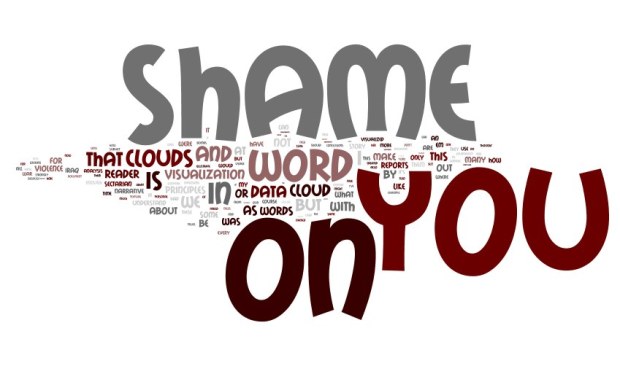Jacob Harris, a New York Times senior software architect, rants about how people like to use word clouds to tell stories:
Of course, the biggest problem with word clouds is that they are often applied to situations where textual analysis is not appropriate. One could argue that word clouds make sense when the point is to specifically analyze word usage (though I’d still suggest alternatives), but it’s ludicrous to make sense of a complex topic like the Iraq War by looking only at the words used to describe the events. Don’t confuse signifiers with what they signify.
Harris says he dies a little inside every time he sees a word cloud presented as insight. Hopefully his computer doesn’t catch a virus that permanently changes his wallpaper, screensaver, and every text document he’s ever written into word clouds, or yes, he would die a little inside many times and effectively die a lot inside so much that it might show on the outside.
Dramatics aside, I have to admit it is amusing when I get emails from people who think they have found the holy trinity of analysis, ease-of-use, and aesthetics that is Wordle. It was never intended as a serious analysis tool. Word clouds were originally made popular as a way to navigate tags for bookmarks, but other than that they’re more of a toy and should be treated that way.



 Visualize This: The FlowingData Guide to Design, Visualization, and Statistics (2nd Edition)
Visualize This: The FlowingData Guide to Design, Visualization, and Statistics (2nd Edition)

Thanks Nathan – I agree that word clouds can have an “Ooo, ahhh” effect and then mostly shrugging, though I haven’t (yet) seen sudden death result.
I use Wordle, not to create word clouds, but to get word counts quickly from text files. The word counts from Wordle can then be used to create more insightful text visualizations than word clouds: http://dataremixed.com/2011/09/24hrs-of-strataconf-tweets/
I came to post something similar to Ben. I’ve found Wordle (both clouds and associated word count lists) very useful for quick, preliminary overviews of really large sets of text – but I wouldn’t use the clouds for rigorous analyses.
As a side note, I also really like how the journal Cartographic Perspectives (http://nacis.org/index.cfm?x=5) uses word clouds before their articles – providing a sort of visual abstract. I’d imagine the sign/signifier disadvantages that Jacob Harris mentioned are still relevant, though. Are there other journals that do this?
I wrote a paper on tag/word clouds in library school. The phrase I came up to describe them with was “semantic cartograms”. They are good for getting the gist of a text at a glance, but I’m not sure they are useful for other purposes.